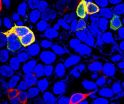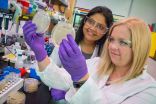(Press-News.org) CLEVELAND—Artificial platelet mimics developed by a research team from Case Western Reserve University and University of California, Santa Barbara, are able to halt bleeding in mouse models 65 percent faster than nature can on its own.
For the first time, the researchers have been able to integratively mimic the shape, size, flexibility and surface chemistry of real blood platelets on albumin-based particle platforms. The researchers believe these four design factors together are important in inducing clots to form faster selectively at vascular injury sites while preventing harmful clots from forming indiscriminately elsewhere in the body.
The new technology, reported in the journal ACS Nano at http://pubs.acs.org/doi/abs/10.1021/nn503732m, is aimed at stemming bleeding in patients suffering from traumatic injury, undergoing surgeries or suffering clotting disorders from platelet defects or a lack of platelets. Further, the technology may be used to deliver drugs to target sites in patients suffering atherosclerosis, thrombosis or other platelet-involved pathologic conditions.
Anirban Sen Gupta, an associate professor of biomedical engineering at Case Western Reserve, previously designed peptide-based surface chemistries that mimic the clot-relevant activities of real platelets. Building on this work, Sen Gupta now focuses on incorporating morphological and mechanical cues that are naturally present in platelets to further refine the design.
"Morphological and mechanical factors influence the margination of natural platelets to the blood vessel wall, and only when they are near the wall can the critical clot-promoting chemical interactions take place," he said.
These natural cues motivated Sen Gupta to team up with Samir Mitragotri, a professor of chemical engineering at UC Santa Barbara, whose laboratory has recently developed albumin-based technologies to make particles that mimic the geometry and mechanical properties of red blood cells and platelets.
Together, the team has developed artificial platelet-like nanoparticles (PLNs) that combine morphological, mechanical and surface chemical properties of natural platelets.
The researchers believe this refined design will be able to simulate natural platelet's ability to collide effectively with larger and softer red blood cells in systemic blood flow. The collisions cause margination—pushing the platelets out of the main flow and closer to the blood vessel wall— increasing the probability of interacting with an injury site.
The surface coatings enable the artificial platelets to anchor to injury-site-specific proteins, von Willebrand Factor and collagen, while inducing the natural and artificial platelets to aggregate faster at the injury site.
Testing in mouse models showed that intravenous injection of these artificial platelets formed clots at the site of injury three times faster than natural platelets alone in control mice.
The ability to interact selectively with injury site proteins, as well as the ability to remain mechanically flexible like natural platelets, enables these artificial platelets to safely ride through the smallest of blood vessels without causing unwanted clots.
Albumin, a protein found in blood serum and eggs, is already used with cancer drugs and considered a safe material. Artificial platelets that don't become involved in a clot and continue to circulate are metabolized within one to two days.
The researchers believe the new artificial platelet design may be even more effective in larger volume blood flows where margination to the blood vessel wall is more prominent. They expect to soon begin testing those capabilities.
This research was previously funded by American Heart Association and is currently funded by National Institutes of Health.
In addition to stemming bleeding, Sen Gupta believes the technology could also be useful in delivering clot-busting medicines directly to clots, to treat heart attack or stroke without having to systemically suspend the body's coagulation mechanism. The artificial platelets may also be used to deliver cancer medicines to metastatic tumors that have high platelet interactions. Sen Gupta is seeking grants to pursue that work.
INFORMATION:
INFORMATION:
Alexandria, Va. — Earth's abundant silicate minerals are degraded over time by exposure to water, chemical dissolution, and physical and chemical weathering by tree roots and even insects such as ants and termites. Such weathering plays a significant role in decreasing carbon dioxide in the atmosphere, as carbon dioxide is consumed in chemical weathering reactions and the resultant carbonate becomes sequestered in the form of limestone and dolomite.
To study the effects of weathering over time, researchers buried basalt sand at multiple test sites and dug up the ...
BUFFALO, N.Y. – Empathy is among humanity's defining characteristics. Understanding another person's plight can inspire gentle emotions and encourage nurturing behaviors.
Yet under certain circumstances, feelings of warmth, tenderness and sympathy can in fact predict aggressive behaviors, according to a recent study by two University at Buffalo researchers.
But why?
That an expression of kindness might be manifest as a punch in the nose can leave observers scratching their heads.
The answer is that it's not about anger or feeling personally threatened, says ...
"New Rochelle, NY, November 5, 2014—The e-incubator, an innovative miniature incubator that is compatible with magnetic resonance imaging (MRI), enables scientists to grow tissue-engineered constructs under controlled conditions and to study their growth and development in real-time without risk of contamination or damage. Offering the potential to test engineered tissues before human transplantation, increase the success rate of implantation, and accelerate the translation of tissue engineering methods from the lab to the clinic, the novel e-incubator is described ...
INDIANAPOLIS -- Indiana University School of Medicine researchers have identified a small protein with a big role in lowering plasma glucose and increasing insulin sensitivity. Their research appeared online today in Diabetes, the journal of the American Diabetes Association.
The report indicates that Sestrin 3 plays a critical role in regulating molecular pathways that control the production of glucose and insulin sensitivity in the liver, making it a logical target for drug development for type 2 diabetes and metabolic syndrome, which can produce increased blood pressure, ...
Researchers from Northeastern University's Marine Science Center and the University of North Carolina at Chapel Hill have found that moderate ocean acidification and warming can actually enhance the growth rate of one reef-building coral species. Only under extreme acidification and thermal conditions did calcification decline.
Their work, which was published Wednesday in the journal Proceedings of the Royal Society B: Biological Sciences, is the first to show that some corals may benefit from moderate ocean acidification.
Justin Ries, an associate professor ...
WASHINGTON, DC—November 4, 2014—An international team of bioengineers has boosted the ability of bacteria to produce isopentenol, a compound with desirable gasoline properties. The finding, published in mBio®, the online open-access journal of the American Society for Microbiology, is a significant step toward developing a bacterial strain that can yield industrial quantities of renewable bio-gasoline.
The metabolic engineering steps to produce short-chain alcohol solvents like isopentenol in the laboratory bacteria Escherichia coli have been worked on ...
From water marks to colored threads, governments are constantly adding new features to paper money to stay one step ahead of counterfeiters. Now a longhorn beetle has inspired yet another way to foil cash fraud, as well as to produce colorful, changing billboards and art displays. In the journal ACS Nano, researchers report a new kind of ink that mimics the beetle's color-shifting ability in a way that would be long-lasting and difficult to copy.
Zhongze Gu, Zhuoying Xie, Chunwei Yuan and colleagues explain that some U.S. bills have color-changing features to help thwart ...
Researchers from MIPT and the Weizmann Institute of Science (Israel) have predicted the possibility of negative turbophoresis, a phenomenon where impurity particles inside a turbulent flow move in an "impossible" direction. The study by Sergei Belan (a postgraduate at MIPT), Grigory Falkovich and Itzhak Fouxon was published in the journal Physical Review Letters in the Editors' Suggestions section, which features the most important and interesting studies from the editorial board's point of view.
The researchers studied the behavior of inertial particles in different ...
An international study has devised a new measure for the "livability" of major cities across the world. The Global Liveable Cities Index (GLCI) takes into account the sensibilities of ordinary working people from 64 cities, balancing work and play, environmental awareness, localism, globalism and many other factors. Details are published in the World Review of Science, Technology and Sustainable Development.
According to Tan Khee Giap of the National University of Singapore and colleagues at University of California, Davis, and Curtin University, in Bentley, Australia, ...
In a recent paper published in Nature Nanotechnology, Joel Moser and ICFO colleagues of the NanoOptoMechanics research group led by Prof. Adrian Bachtold, together with Marc Dykman (Michigan University), report on an experiment in which a carbon nanotube mechanical resonator exhibits quality factors of up to 5 million, 30 times better than the best quality factors measured in nanotubes to date.
Imagine that the host of a dinner party tries to get his guests' attention by giving a single tap of his oyster spoon on his crystal glass. Now, imagine, to the amazement of all, ...







